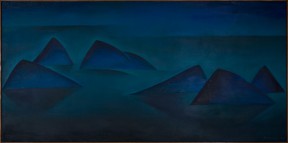Collection Pairs
17 October - 7 December 2014
The Barry Hopkins Gallery
The inaugural exhibition in The Barry Hopkins Gallery exploits the relationships of the Barry Hopkins Collection in relation to the Museum’s other art collections.
Image: Cavalli Islands ‘The Islands’, Freda Simmonds, oil on canvas, 1969, Barry Hopkins Collection
Collection Pairs
Artists: Freda Simmonds, Colin McCahon, Mary McIntyre, Gordon Walters, Michael Illingworth, Milan Mrkusich, Brent Wong, Ev Gardiner, Claudia Pond-Eyley, James Ormsby, Buck Nin, David Woodings, Michael Smither, Fatu Feu’u, Tony Fomison, Philip Clairmont and Andrea du Chatenier
Curated by Barry Hopkins
The treasured object exists not principally to be owned but to be viewed. Even the fantasy of possession is no longer central to the museum gaze, or rather it has been inverted, so that the object in its essence seems not be a possession but rather to be itself the possessor of what is most valuable and enduring. What the work possesses is the power to arouse wonder, and that power, in the dominant aesthetic ideology of the West, has been infused with the creative genius of the artist.
Stephen Greenblatt, from his essay, ‘Resonance and Wonder’, p.53, Exhibiting Cultures: The Poetics and Politics of Museum Display. Edited by Ivan Karp and Steven D. Lavine, 1990, published by the Smithsonian Institution.
Part of the curator’s job is to find engaging ways to extrapolate meaning for the museum-goer through the use of objects, art and taonga. These often come directly from the collections that belong to the institution. Generating connections between disparate works of art objects gives us an inroad to the often opaque concepts that an artist employs. Barry Hopkins’ idea for Collection Pairs was to find works from the various fine arts collections and couple them, using the ‘artist’ as the key. His sense of mischief as a collector and curator uses the artist’s paired work as an experiment to test how they might sit alongside one another. This choice is analogous to seating rivalrous siblings next to one another at the table. They may get along, they may not. Either way, it is our viewing of these pairs that is critical to our ability see the commonalities and likewise, developments in the artist’s work. By doing this we add value to the overall experience of ‘seeing’.
In the hubbub of picking up of conversations recent or past, the artists’ works straddle up next one another. Colin McCahon’s two waterfall works could be said to be from a multiple birth, whereas the development between the older (Walkway, 1980) and more recent works (Out of order, #3 for Bob, 2013) of David Woodings are more like oldest and youngest siblings: time shows evidence of Woodings’ shift in subject matter, media and life circumstances. The paired works allow us into the secrets of their maker to some degree. While some pairs let us bask in the comforting familiar styles of solid favourites such as Claudia Pond-Eyley’s First shield, 1983 and Primitive Goddess with the Maungawhau, 1980.
The Barry Hopkins Collection ‘moved in’ to the Waikato Museum in 2008 and will remain here for the foreseeable future. These pairings come from Hopkins’ own intimate knowledge of his collection as well as the museum’s art collection, which he has become familiar with during 40 years of involvement with the Friends of Waikato Museum and Waikato Society of Arts. As a collector, he is not altogether concerned about the monetary or investment value of art so much as the power it possesses to speak to his sensibilities.
Leafa Wilson
Curator (Art)
Waikato Museum
Te Whare Taonga o Waikato
2014
Related news - New Gallery Extends Hamilton's Arts Offer


